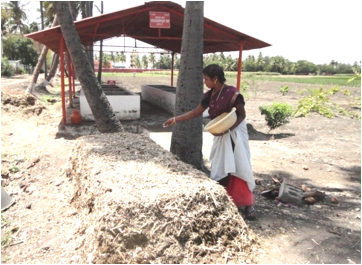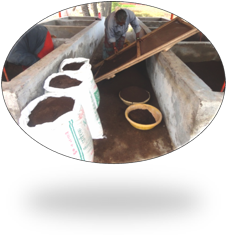
Vermicompost bio fertilizer is a one of the important natural fertilizers. In the past, agriculture was done ??using only natural fertilizers. Because of this increased production and also soil fertility was preserved. But the current situation due to growing population, because of Green Revolution, by using chemical fertilizers high yielding varieties were developed. Excessive use of chemical fertilizers and pesticides caused reduction in soil fertility and also reduced the number of beneficial microorganisms. Therefore, conversion this degraded land into fertile lands, organic manures play a major role fro the transformation.
Naturally available organic residues ingested by worms. It was digested by the intestine micro organisms and enzymes and then tiny pellets form forced out through anal of the earthworm is called vermi composting.
Earth warm is called as "farmer's friend". According to living place, earthworm is categorized as top, intermediate and grassroots worms. Top and intermediate type of earth warm’s best suited to produce compost. Earthworms take food as 2 to 5 times organic matter of its body weight, out of this 5 -10% of them spend as food and the rest of the organic matter was excreted as fertilizer.
 Selection of earth worm:
Despite, nearly 3,000 varieties of earthworms available worms such as Yutirilus and Yujiniya of African species were suitable for commercial production of manure. Because these are top feeders in the soil. The species should have higher reproduction rate, adjusting to climatic conditions and economic importance has to be selected. And also reproduce quickly, suitable for temperatures and with the economic importance of the species should be selected. Periyonics excavators Utrilus yujiniye, and Eyciniya pettida such kind of earth worm, much as it has been used to produce vermicompost. Selection of earth worm:
Despite, nearly 3,000 varieties of earthworms available worms such as Yutirilus and Yujiniya of African species were suitable for commercial production of manure. Because these are top feeders in the soil. The species should have higher reproduction rate, adjusting to climatic conditions and economic importance has to be selected. And also reproduce quickly, suitable for temperatures and with the economic importance of the species should be selected. Periyonics excavators Utrilus yujiniye, and Eyciniya pettida such kind of earth worm, much as it has been used to produce vermicompost.
Collecting Earthworms:
Using local earth worm helps to improve the fertility of the soil and environment. Choose a shady place in the garden. The place of tree shade might have not applied chemical fertilizers or select the place where organic waste from the house passing out would be right choice.
Choose a small place and spread cow dung and place on straw or sprinkle dust and cover with old gunny bags and frequently sprinkle water based on need. After two weeks we can see top and middle layer earthworms. While collecting earth worms soil also to be taken together.

Culturing of earth worms and manufacturing fertilizers, worms are fed continuously. Nitrogen rich cow dung, goat dung and pig dung may be used as feed.
Earthworm Production Systems:
Vermicompost production methods may change acccording to prevalent situation in the place of worm culturing area. Some of the methods which include are cavity, basin system and bed methods etc.
Cavity method is a very simple method for preparation of the earthworm manure. In this method large scale vermicompost production is possible on commercial scale. In this system, long beds are prepared and grow worms and produced fertilizer.
In this method, dig a pit in the dimension of 10" x 3" x 2" on a shaded and elevated surface and even extend the length up to 20 feet. Release 2000 – 2500 earth worms per square metre.
Thus, inner side of the excavated pit is lined with bricks. Bottom of the pit has to be filled with coir waste or Agriculture waste. Finally add cow dung or decomposed agriculture waste or leaves has to be spread over there. Finally cover the pit with bio gas slurry or cow dung mixture and release the earth worms. After this pits were covered with straw or stakes to preserve the moisture.
Separation method of earthworm excreta:

Once decided to collect the excreta, stop sprinkling water two days in advance. Earth worms moves to moisturized portion in the bottom. This is directly used for cultivated land or long term usage, bagged it without loss in moisture and it was used later. If maintained the compost without loss in moisture, it can be used for six to eight months.
Uses:
- Increasing the microorganisms populations in the soil.
- Increase the soil aeration.
- Play a role in increasing the growth of roots.
- Environmental protection.
|




